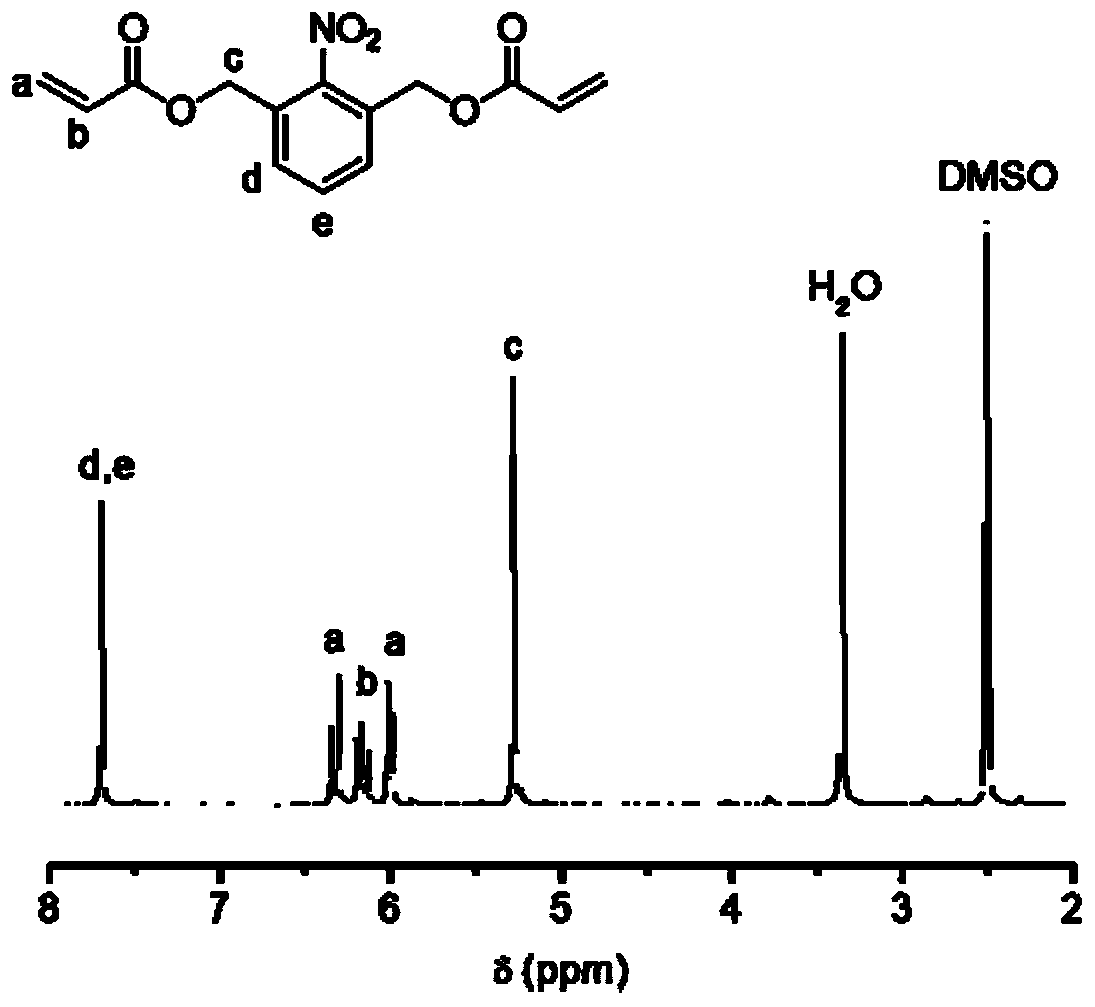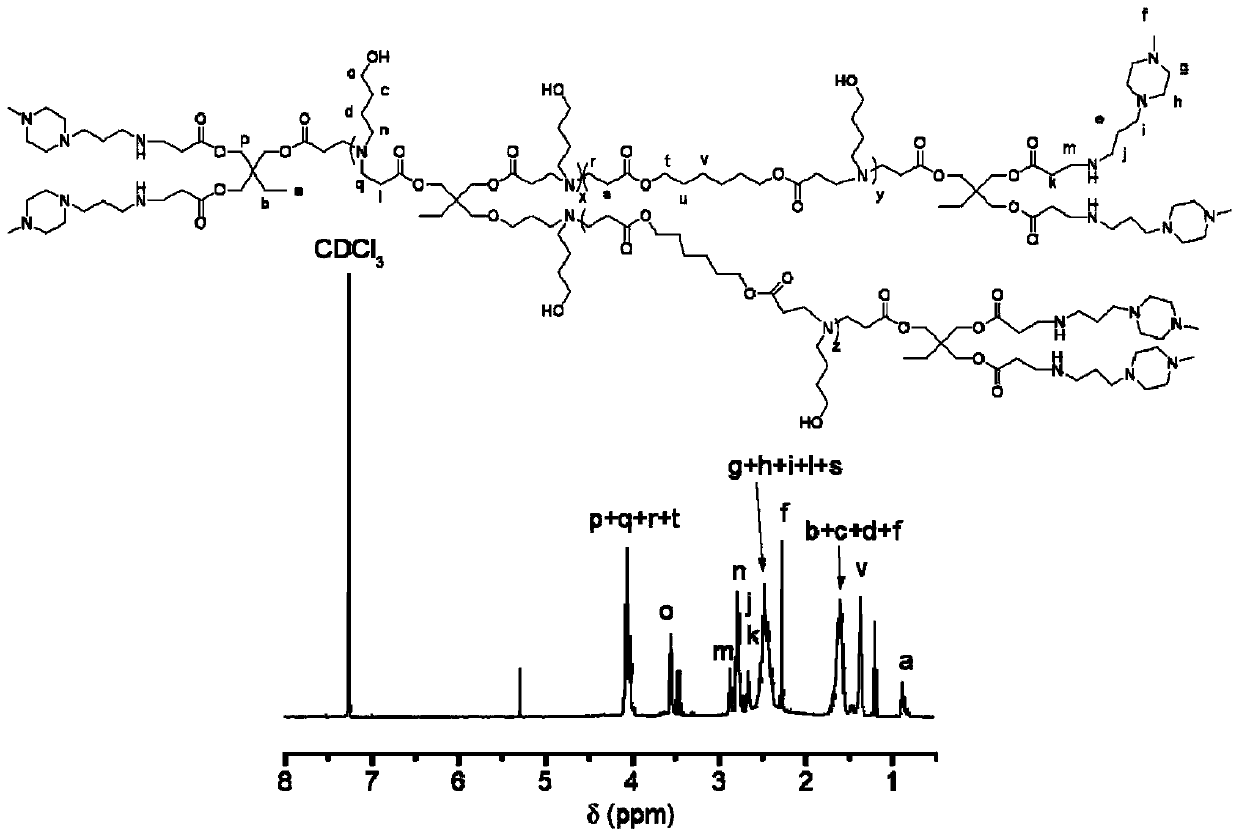UV photoresponsive hyperbranched poly(belta-amino esters) with efficient gene delivery capability, and preparation method and application thereof
A light-responsive, hyperbranched polymerization technology, which can be used in medical preparations with inactive ingredients, other methods of inserting foreign genetic materials, and pharmaceutical formulations. It can solve problems such as high cytotoxicity, improve transfection efficiency, promote interaction, enhancing the effect of electrostatic interactions
- Summary
- Abstract
- Description
- Claims
- Application Information
AI Technical Summary
Problems solved by technology
Method used
Image
Examples
Embodiment 1
[0067] The method for preparing UV photoresponsive hyperbranched poly-β-amino ester is as follows:
[0068] Add 2,6-dimethylnitrobenzene (15g, 0.15mol) to 95 o C NaOH solution was stirred evenly, then potassium permanganate (66 g, 0.418 mol) was added, and then refluxed for 24 h; then the mixture was cooled to room temperature, filtered, and the filtrate was adjusted to pH 1 with hydrochloric acid to obtain the white solid product 2- Nitro-1,3-phthalic acid.
[0069] Under the condition of ice bath, 1.0 mol borane (in tetrahydrofuran complex, 400mL) was added into 2-nitro-1, 3-benzenedicarboxylic acid (16.0 g, 76 mmol) and dissolved in The mixture was obtained in a solution of tetrahydrofuran in water; the mixture was heated to room temperature and stirred for 48h; then methanol (40mL) was added dropwise, filtered and dried under vacuum, then the dry matter was dissolved in ethyl acetate and washed with saturated NaCl solution (4 × 100 mL), and the organic phase was dried wi...
Embodiment 2
[0072] 2-Nitro-1,3-diacrylate m-xylylene (174.6 mg, 0.6 mmol), trimethylolpropane triacrylate (74 mg, 0.25 mmol) and 4-amino-1-butanol ( 89 mg, 1 mmol) were mixed, and reacted at 60°C for 8 h without solvent; then added (3-aminopropyl)-4-methylpiperazine (157 mg, 1 mmol) in dichloromethane mL), reacted at room temperature for 12 hours; then settled three times with glacial ether, and removed the solvent under vacuum to obtain a yellow viscous oil, that is, UV photoresponsive hyperbranched poly-β-amino ester (BPAE-NB), with a total yield of 72%. . Deuterated chloroform for NMR, with figure 2 Its nuclear magnetic spectrum, x is 9-11, y is 8-10, z is 7-9. The chemical structural formula of BPAE-NB is as follows:
[0073]
[0074] The polymer was treated with UV light (365 nm, 20 mW / cm2, 5 min) and the molecular weight of the polymer before and after treatment was determined by GPC.
Embodiment 3
[0084] Example 3 Preparation, characterization and performance of DNA-loaded nanomedicine
[0085] Prepare the poly-β-amino ester (BPAE-NB) of Example 2 with an acetate buffer solution (pH = 5.2) at a concentration of 1 mg / mL and DNA (plasmid DNA, a plasmid containing luciferase expression extracted from Escherichia coli, a conventional product ) DEPC aqueous solution at a concentration of 0.1 mg / mL; then DNA and poly-β-amino ester were mixed in different weight ratios (1 / 0.5, 1 / 1, 1 / 5, 1 / 10 and 1 / 15), and the mixture was vortexed 10 sec, followed by incubation at 37°C for 30 min to form poly-β-amino ester / DNA complexes. Load the sample into the sample well by 1% agarose gel electrophoresis, run at 100 V for 40 min, stain with ethidium bromide, and image with a gel imaging system to measure the encapsulation efficiency of DNA.
[0086] DNA and poly-β-amino ester were mixed in different weight ratios (1 / 0.2, 1 / 0.5, 1 / 1, 1 / 2 and 1 / 5), the mixture was vortexed for 10 seconds, an...
PUM
| Property | Measurement | Unit |
|---|---|---|
| particle diameter | aaaaa | aaaaa |
| particle diameter | aaaaa | aaaaa |
| particle diameter | aaaaa | aaaaa |
Abstract
Description
Claims
Application Information
 Login to View More
Login to View More - R&D
- Intellectual Property
- Life Sciences
- Materials
- Tech Scout
- Unparalleled Data Quality
- Higher Quality Content
- 60% Fewer Hallucinations
Browse by: Latest US Patents, China's latest patents, Technical Efficacy Thesaurus, Application Domain, Technology Topic, Popular Technical Reports.
© 2025 PatSnap. All rights reserved.Legal|Privacy policy|Modern Slavery Act Transparency Statement|Sitemap|About US| Contact US: help@patsnap.com



